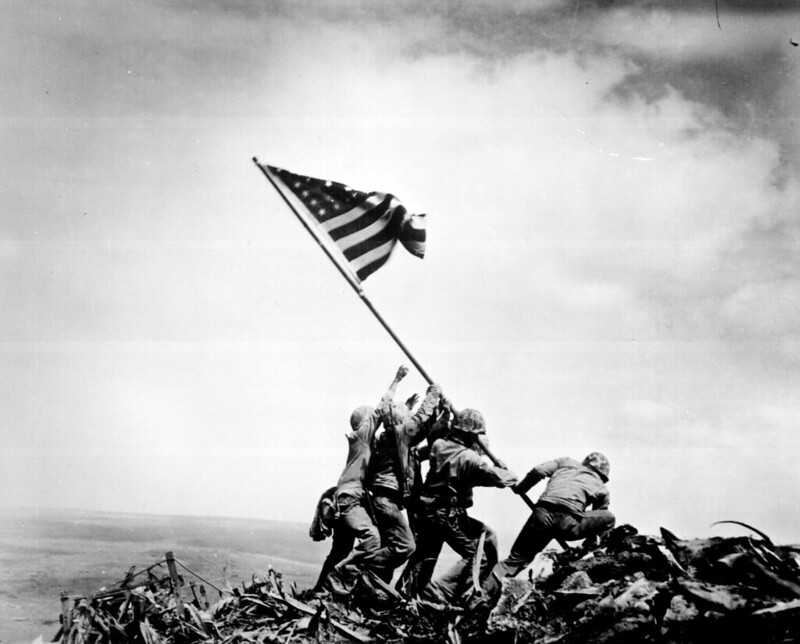Beginning on December 7, 1941, with the Japanese attack on the naval base at Pearl Harbor, Hawaii until the final surrender of Japan on September 2, 1945, the United States was involved in a brutal war in the Pacific. Allied with Britain and France, U.S. troops fought against Germany and Italy in Europe, while at the same time, battling against Japan in the Pacific Islands. By 1942, Japan had seized Guam, Wake Island, Hong Kong, and Singapore; they had control of the Pacific. Following a major victory over Japan in the Battle of Midway, the United States began to gain some ground against Japan through their island-hopping campaign. With this strategy, the United States would first bomb a Japanese-controlled island, then send troops ashore for combat. They slowly began regaining control of the Pacific one island at a time.
One of the most significant battles during the island-hopping campaign was the Battle of Iwo Jima. While the picture displays several U.S. Marines raising the American flag in victory over Mount Suribachi, the U.S. Navy, Air Corps, and Army also played a major role in the battle((Douglas E. Nash, “Army Boots on Volcanic Sands: The 147th Infantry Regiment at Iwo Jima.” Army History no.105 (2017): 6.)). The Air Corps led the initial bombing strike on the island of Iwo Jima, then the Marines and Army regiments followed with the land assault, following the battle strategy of the island-hopping campaign. Even before the island was secured, the Air Corps used Iwo Jima as an emergency divert field((Russ, John A. “VLR!: VII Fighter Command Operations from Iwo Jima, April-August 1945.” Air Power History 48, no. 3 (2001): 19.)). Major Philip True of the Army Air Force was one of the pilots who used Iwo Jima for an emergency landing after his plane was caught in the flak of the Japanese anti-aircraft artillery((True, Philip A. “Will We Make Iwo?” Air Power History 41, no. 1 (1994): 9.)). He was nearly forced to bail out or ditch his plane in the ocean, but he and his crew made it safely to Iwo Jima((True, “Will We Make Iwo?”: 13.)). Capturing this island was crucial in regaining control of the other islands in the Pacific, defending the Philippines, and gaining access to Japan.
Iwo Jima was one of the bloodiest battles during the War in the Pacific, with the loss 24,053 marines and sailors((Nash, “Army Boots on Volcanic Sands”: 7.)). However, following over two weeks of fighting, the United States secured the island and raised the American flag on top of Mount Suribachi. This picture was taken as the six Marines hoisted the flag in victory. In Washington, D.C., there is a monument erected as a tribute to the United States Marine Corps. The Iwo Jima Memorial is a replica of this picture, honoring the men who sacrificed their lives fighting this battle, as well as honoring all those who fought in the second world war. Among the men captured in this iconic photo was Ira Hayes, a Native American from the Pima Tribe. Many Native Americans played key roles during the war as Code Talkers, using their native languages so the Japanese were unable to decipher the American codes, allowing the United States to take Japan by surprise or keep them unaware of their location and strategies. The story of Ira Hayes was memorialized in a song by Johnny Cash, “The Ballad of Ira Hayes”.
This photo captures the victory over this battle, demonstrating the strength and comaraderie of the American forces amidst a difficult battle and exhausting war. The soldiers raising the flag are the center of the picture; the photographer wanted the focus on these men displaying their hard-fought victory and not on the surrounding destruction on the island. So many lives were lost in this battle, but this photo capitalizes on those who survived and their final securing of the island. At the same time, the raising of the flag honors the many soldiers who sacrificed their lives in this battle.
Raising the Flag Over Iwo Jima
1940-1950, 20th Century
My father during world War 2 was in the Army air corps and told family members he was present and saw the raising of the flag on Iwo Jima. Why is little said or even the present of the Army air corps army being on the Mount. Also another family inlaw father that served in the Army air corps was present during the raising of the flag. Army air corps were important on Iwo Jima and need to be mentioned.